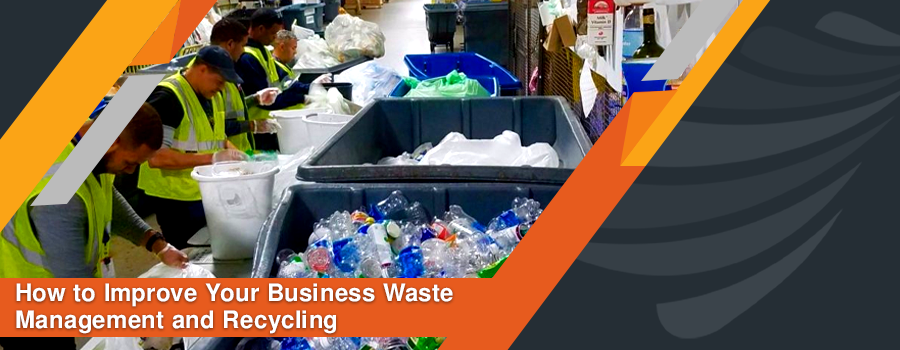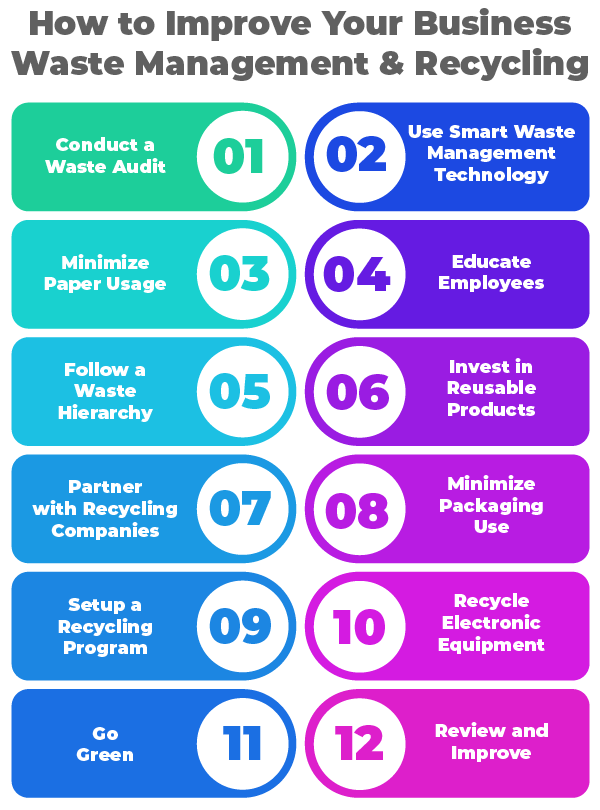Business owners are under increasing pressure to minimize their environmental impact and adopt sustainable solutions in today’s increasingly eco-conscious market. Efficient garbage handling mitigates ecological damage and offers prospects for financial savings and advantageous brand distinction.
As a business owner or entrepreneur, you are crucial in waste generation, management, and recycling. Your decisions and actions can make a significant difference. If you have concerns in these areas, we are here to guide you and empower you to take control of your business’s environmental impact. We will provide the latest technologies and statistics to help you make informed decisions.
Global Office Waste Statistics
Offices worldwide are significant contributors to waste generation, which has profound implications for environmental sustainability. As concerns about climate change and resource depletion escalate, the need for companies to prioritize waste reduction and adopt eco-friendly workplace practices becomes more urgent.
Office spaces are major contributors to waste generation worldwide, significantly impacting environmental sustainability. According to the Environmental Protection Agency (EPA), the average citizen in the United States generates 4.4 pounds of waste daily. Additionally, the United States reveals that business waste constitutes around 20% of global waste, with offices being the significant contributors.
On the other hand, office workers, on their level, generate waste of around 2 pounds every day. This waste includes food, plastic, and paper. Surprisingly, disposable paper and paperboard alone are responsible for a quarter of landfill waste and a third of municipal waste. The disposal and production of paper products are a waste of resources and substantial energy, exacerbating water scarcity and climate change concerns.
Top 12 Best Ways to Improve Your Business Waste Management and Recycling
The 12 best ways to improve your business waste management and recycling are:
1. Conduct a Waste Audit
A waste audit is a structured process organizations use to quantify the amount and types of waste generated. Audit information helps identify current waste practices and how they can be improved.
You must evaluate your current waste generation and disposable practices, such as what material you are currently disposing of and in what quantity. Accordingly, evaluate which material can be recycled, reduced, and reused. To ensure best practices, you can form a team, set a specific day for the team to conduct waste audits, and make a report.
2. Use Smart Waste Management Technology
To manage waste, you can install BinWise, a smart waste management solution, in your parking spaces, lobby, and waste collection areas. BinWise provides real-time monitoring and analytics of waste collection, route optimization, and schedules to reduce waste. Also, it allows waste to be collected only when the bins are filled, making waste management efficient, time-saving, and convenient.
3. Minimize Paper Usage
Unfortunately, an ordinary full-time office worker uses 10,000 sheets of copy paper annually: four boxes or twenty reams of paper, with 500 sheets per ream. To minimize word cutting, paper waste must be reduced. You must also try to work and communicate digitally, which is convenient and safe. If there is an urgent need for printing, you can print on the double side and recycle paper where possible.
4. Educate Employees
Educating employees about the adoption of waste management and recycling is very important. Providing training and workshops and involving them in recycling activities can benefit you. You can arrange quarterly or monthly recycling days, where employees can participate in activities promoting recycling and sustainability. These events can include workshops, presentations, or social activities like planting trees or participating in recycling drives.
5. Follow a Waste Hierarchy
In a waste hierarchy, preventing waste is the priority. When garbage is produced, the processes of preparation for reuse come first, followed by recycling, other recovery, and disposal (i.e., landfilling). You can observe the waste hierarchy’s reduction, reuse, recycling, and disposal guidelines as a last resort. You can arrange programs for trash prevention and reuse precedence over recycling whenever feasible.
6. Invest in Reusable Products
There are abundant reusable and disposable biobased product choices. You can switch to compostable cutlery made of renewable materials like bamboo or bioplastics like PLA (polylactic acid). These cutlery pieces decompose organically, resulting in no enduring ecological damage. Moreover, you can opt for additional reusable substitutes like cloth shopping bags, glass food containers, and stainless-steel straws. By utilizing reusable products, your company may drastically lessen its environmental impact and help create a more sustainable future.
7. Partner with Recycling Companies
You can collaborate with waste management or recycling companies to ensure that recycled material is properly collected, processed, and recycled and that the waste is properly disposed of. The collaboration also allows you to get innovative ideas and integrate advanced technologies to manage waste and even increase your revenue and
8. Minimize Packaging Use
Choose package options that put efficiency and sustainability first to cut waste in all aspects of your company’s operations. To reduce your influence on the environment, look at alternatives like recyclable and biodegradable eco-friendly packaging materials. Furthermore, contemplate using strategies such as purchasing in bulk to minimize the requirement for surplus packing materials. Your company can dramatically reduce its environmental impact while preserving product quality and delivery efficiency by optimizing packing procedures and prioritizing sustainable choices.
9. Setup a Recycling Program
You can strategically place recycling bins with clear labeling throughout the office. For better management, you can place it in high-traffic areas, ideally next to desks, break rooms, and copy/print stations. To speed up the sorting process, ensure each bin is clearly labeled for materials like paper, plastic, glass, and metal. This accessibility promotes appropriate recycling disposal among staff members and fosters a sustainable work environment. You must ensure that the bins are emptied regularly to ensure that waste management procedures are efficient and clean.
10. Recycle Electronic Equipment
Recycling electronic equipment helps to reduce electronic waste, preserve valuable resources, and save costs. You can initiate it by locating certified e-waste recyclers that follow environmentally responsible practices. Before recycling, you need to ensure that the sensitive information is saved on the cloud and information from the device is removed. For efficient recycling, you can separate components and consider options for reuse or refurbishment where feasible. Also, instead of throwing away outdated electronics in the usual trash can, encourage staff members to bring them in for recycling and train them to adopt safe disposal techniques.
11. Go Green
‘Go green’ in your office means implementing environment-friendly practices to reduce ecological footprints. You can start by adopting energy-saving measures like adjusting thermostat settings for optimal energy use and using energy-efficient equipment. Also, you can encourage employees to adopt paperless practices and encourage recycling practices. You can invest in eco-friendly office supplies made from recycled materials, opt for renewable energy sources like solar power, and support green transportation options like carpooling and van services. Promoting a culture of sustainability is necessary by training and educating employees about the significance of going green and being involved in eco-friendly initiatives.
12. Review and Improve
To ensure that your organization’s recycling and waste management practices continue, you must evaluate and review your waste management practices in a timely manner and look for opportunities to further optimize efficiency and sustainability. You should also seek feedback from stakeholders and employees to identify areas for improvement.
To Sum Up
Implementation of effective waste management and recycling is necessary for operational efficiency and environmental sustainability. By adopting strategies like implementing recycling programs, limiting paper use, and conducting waste audits, businesses significantly reduce ecological footprints and save cost. By prioritizing waste management and recycling initiatives, businesses can contribute to community awareness, fulfill environmental and social responsibility, and make a positive impact on the surroundings. With continuous evaluation and improvement of waste management and recycling practices, businesses can pave the way for a more sustainable future.





